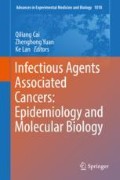Abstract
Emerging evidence has demonstrated that almost each person is infected at least one potentially cancer-causing organism; however, only a small proportion of infected individual develops cancer. In this review, to elucidate the potential role of infectious organisms in the development and progression of human cancers, we summarize the previous history and current understandings of infection-associated cancers and highlight the common molecular mechanisms of cancers caused by infectious agents and their potential cofactors, which may bring us to effectively prevent and reduce the infection-associated cancers in the future.
Access this chapter
Tax calculation will be finalised at checkout
Purchases are for personal use only
References
de Martel C, Ferlay J, Franceschi S, Vignat J, Bray F, Forman D et al (2012) Global burden of cancers attributable to infections in 2008: a review and synthetic analysis. Lancet Oncol 13:607–615
Javier RT, Butel JS (2008) The history of tumor virology. Cancer Res 68:7693–7706
Rous P (1911) A sarcoma of the fowl transmissible by an agent separable from the tumor cells. J Exp Med 13:397–411
Rous P (1910) A transmissible avian neoplasm. (Sarcoma of the common fowl.) J Exp Med 12:696–705
Shope RE, Hurst EW (1933) Infectious papillomatosis of rabbits : with a note on the histopathology. J Exp Med 58:607–624
Hitchcock CR, Bell ET (1952) Studies on the nematode parasite, Gongylonema neoplasticum (spiroptera neoplasticum), and avitaminosis A in the forestomach of rats: comparison with Fibiger’s results. J Natl Cancer Inst 12:1345–1387
Raju TN (1998) The nobel chronicles. 1926: Johannes Andreas Grib Fibiger (1867–1928). Lancet 352:1635
Vogt PK (1996) Peyton Rous: homage and appraisal. FASEB J Off Publ Fed Am Soc Exp Biol 10:1559–1562
Jackson RB, Little CC (1933) The existence of non-chromosomal influence in the incidence of mammary tumors in mice. Science 78:465–466
Burkitt D (1958) A sarcoma involving the jaws in African children. Br J Surg 46:218–223
Coakley D (2006) Denis Burkitt and his contribution to haematology/oncology. Br J Haematol 135:17–25
Epstein MA, Achong BG, Barr YM (1964) Virus particles in cultured lymphoblasts from Burkitt’s lymphoma. Lancet 1:702–703
Baer R, Bankier AT, Biggin MD, Deininger PL, Farrell PJ, Gibson TJ et al (1984) DNA sequence and expression of the B95-8 Epstein-Barr virus genome. Nature 310:207–211
Marshall BJ, Warren JR (1984) Unidentified curved bacilli in the stomach of patients with gastritis and peptic ulceration. Lancet 1:1311–1315
Warren JR, Marshall B (1983) Unidentified curved bacilli on gastric epithelium in active chronic gastritis. Lancet 1:1273–1275
Warren JR (2006) Helicobacter: the ease and difficulty of a new discovery (Nobel lecture). ChemMedChem 1:672–685
Huebner RJ, Todaro GJ (1969) Oncogenes of RNA tumor viruses as determinants of cancer. Proc Natl Acad Sci U S A 64:1087–1094
Stehelin D, Varmus HE, Bishop JM, Vogt PK (1976) DNA related to the transforming gene(s) of avian sarcoma viruses is present in normal avian DNA. Nature 260:170–173
Zur Hausen H, Meinhof W, Scheiber W, Bornkamm GW (1974) Attempts to detect virus-secific DNA in human tumors. I. Nucleic acid hybridizations with complementary RNA of human wart virus. Int J Cancer 13:650–656
Chang Y, Cesarman E, Pessin MS, Lee F, Culpepper J, Knowles DM et al (1994) Identification of herpesvirus-like DNA sequences in AIDS-associated Kaposi’s sarcoma. Science 266:1865–1869
Shuda M, Feng H, Kwun HJ, Rosen ST, Gjoerup O, Moore PS et al (2008) T antigen mutations are a human tumor-specific signature for Merkel cell polyomavirus. Proc Natl Acad Sci U S A 105:16272–16277
Feng H, Shuda M, Chang Y, Moore PS (2008) Clonal integration of a polyomavirus in human Merkel cell carcinoma. Science 319:1096–1100
Knudson AG (2001) Two genetic hits (more or less) to cancer. Nat Rev Cancer 1:157–162
Zhu C, Zhu Q, Wang C, Zhang L, Wei F, Cai Q (2016) Hostile takeover: manipulation of HIF-1 signaling in pathogen-associated cancers (review). Int J Oncol 49:1269–1276
Andersson J (2000) An overview of Epstein-Barr virus: from discovery to future directions for treatment and prevention. Herpes: J IHMF 7:76–82
McGlynn KA, London WT (2005) Epidemiology and natural history of hepatocellular carcinoma. Best Pract Res Clin Gastroenterol 19:3–23
Zur Hausen H (2002) Papillomaviruses and cancer: from basic studies to clinical application. Nat Rev Cancer 2:342–350
Ahmed N, Sechi LA (2005) Helicobacter pylori and gastroduodenal pathology: new threats of the old friend. Ann Clin Microbiol Antimicrob 4:1
Prabhu SR, Amrapurkar AD, Amrapurkar DN (1995) Role of Helicobacter pylori in gastric carcinoma. Natl Med J India 8:58–60
Megraud F, Lehours P (2004) Helicobacter pylori and gastric cancer prevention is possible. Cancer Detect Prev 28:392–398
Author information
Authors and Affiliations
Corresponding author
Editor information
Editors and Affiliations
Rights and permissions
Copyright information
© 2017 Springer Nature Singapore Pte Ltd.
About this chapter
Cite this chapter
Cai, Q., Yuan, Z. (2017). Overview of Infectious Causes of Human Cancers. In: Cai, Q., Yuan, Z., Lan, K. (eds) Infectious Agents Associated Cancers: Epidemiology and Molecular Biology. Advances in Experimental Medicine and Biology, vol 1018. Springer, Singapore. https://doi.org/10.1007/978-981-10-5765-6_1
Download citation
DOI: https://doi.org/10.1007/978-981-10-5765-6_1
Published:
Publisher Name: Springer, Singapore
Print ISBN: 978-981-10-5764-9
Online ISBN: 978-981-10-5765-6
eBook Packages: Biomedical and Life SciencesBiomedical and Life Sciences (R0)

